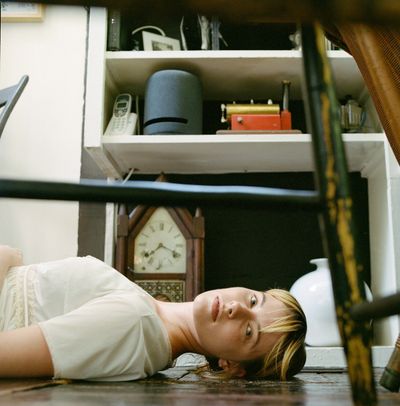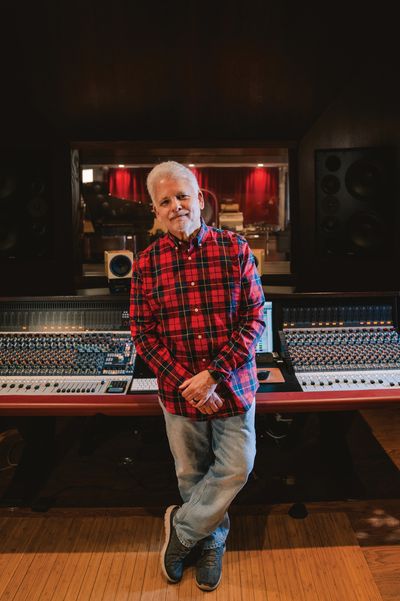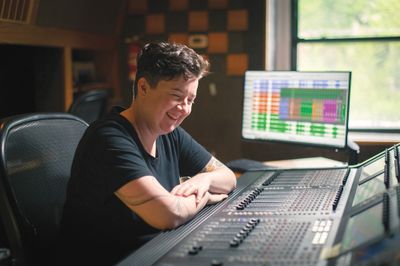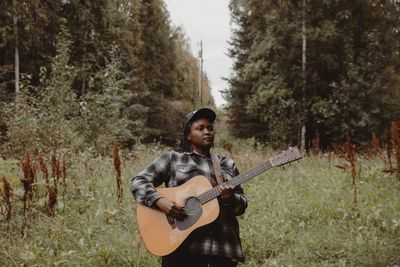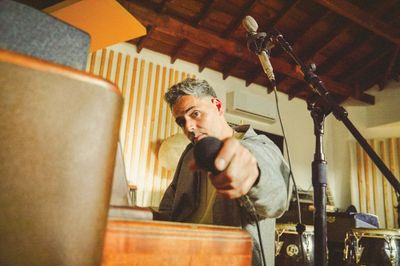How did you get into recording and being an engineer? Did you go to school?
No I didn't. I was intrigued with electric guitars... we're talking mid to late 50's... and I was wanting guitar amplifiers and things like that. One of my friends in grammar school used to work at a hi-fi repair shop. The guy was just a genius in terms of putting stuff together. I had an old tape recorder and he helped me rig it so I could play the guitar into it and actually use the tape recorder and the speaker...
As a little amp?
Exactly! I couldn't afford an amplifier, so I used the little amp in there, and that got me into fooling around with wires and stuff like that. I was in bands all the way through high school, college and afterwards. In the early to mid 70's I was in a group, and we needed to record our own demo. So I got my trusty stereo tape recorder together, which I always had around, and a crude mixer. We sort of pulled together equipment and recorded the demo. But we needed to buy a Shure mixer and a few other pieces of equipment. Once we started gathering some of that stuff, word got around and other people asked us to record their demos.
I helped out some friends of mine who were in The Look. The first time I recorded them I think it was in the basement. Then they wanted me to do a live show, in hopes of getting a better recording. If you can imagine: a Shure mixer with four microphone inputs with very, very cheap microphones. Usually, one microphone would be propped up in front of the PA speaker for the vocals, then three other microphones: one for the drums, or somewhere between the drums and the bass amp, and the other two for guitars. We put the vocals on one stereo channel and everything else on the other. At that particular show, there was a group called the Slickee Boys who were playing too, and they asked me to record them, since I was there. They were an underground band of some renown in the city. So I recorded them, and it turned out... oh I guess reasonably good. Most of the stuff from those days... if you really go back and listen hard... really sucks. But for the time, I guess it was all right. And also for the price, it was all right (laughs).
And what year was this?
About '75 or '76, maybe '77 with The Slickee Boys, I recorded a bunch of other albums, of equal fidelity, probably, and through them got to know Skip Groff, who put out a couple of their records on Limp Records. Skip was really in touch with a lot of the bands who were on the forefront of music like The Slickee Boys, Bad Brains, The Urban Verbs and a bunch of others. So, he brought a few of these bands in to record. Then he brought Minor Threat in. He thought they'd be a good try since they were so raucous and brash. And all of a sudden, I was doing a lot of this punk music recording. This was going on in the evenings. In the daytime, I was working at the National Gallery of Art in Prints and Drawings. Because, basically, my background is in art. So this [recording] is all going on as sort of a life outside my life kind of thing. Eventually, the National Gallery built a studio. This was in the early 80's. But they had problems getting the patchbay together. Since I'd been messing around with this stuff, I said, "I can help you guys connect this thing up and get it going." I think they had two two-track recorders, and that's about it. The mixing board had about four channels. But it was high-quality stuff. (It was used) for narration, mainly, for their programs on tape, audio visual shows, slide shows and things like that. So, I connected that up for them. And immediately after that was done, they didn't have an engineer to run the thing, so I said, "Heck, I wouldn't mind running the thing if you want." So I flipped over into the whole recording side of things as an actual profession. I did that for about five or six years. Then I went to manage a private studio for a while and got out of actual hands-on engineering. I didn't like it at all. I liked fooling with the dials and moving the patches all around the place. After less than a year, I quit there and started my own studio.
Was that when you moved the studio out of your house to another space?
Yes. It's in a separate building a couple miles away. It was a warehouse before, and we built it up as a studio inside. It's got two control rooms. Jay Robbins, of Jawbox, engineers in the 16-track control room. And I do the recording in the 24-track room. There's a couple of other engineers who do things in here every once in a while, too.
What kind of machine do you have in there right now?
It's an Otari MTR-90 (24-track).
And what kind of board and mics are you using most often?
We have an AMEK Angela board. It's one of the original Angelas, which I like very, very much. I have a Fostex E-22 (1/2" 2-track) to mix down to... that or a Tascam DA-30 DAT, the MKII thing. Other than that, there are bunches of outboard gear. The reason I got into recording and the reason I like electronics in general is because it's sort of an experiment, a laboratory. And that's where the fun comes in really. I build electronics myself too. I've built some compressors and some mixers. And I've built noise gates and a lot of things like that. Some of them are more successful than others. I have a (Fostex) B-16, which is now in the 16-track studio, that we modified/hot rodded. Getting something like that tweaked is very satisfying because those machines can be very mundane and pedestrian unless they're really pushed. And when they're really pushed, they can sound quite interesting. Jay's done some fantastic recording on it. My mouth has hung open a few times. And mics, I've got a pretty big collection. Boy, where do I start?
Well, what do you use frequently for snares or for guitars?
For snares, I have the Shure Beta 56, I believe it is. It's their new small one. The (Shure Beta) 57 I use. I use the EV N/D 408. Those are primary things. On kick drum, the (Shure) Beta 52 I like a lot. I use the Equitek E-100 a lot. But there a lot of different things we've played around with. I've taken the Audio Technica 4033 and laid it, literally without a stand or anything, inside the bass drum and covered it with a pillow. And it has some interesting results, not as a primary kick sound but as a nice thickener for the whole thing.
So you'd have another mic that you'd submix that with or put it onto a separate track?
We just throw it on another track. And then, if we decide that it's really bad, we just record over it. A lot of times they do turn out kind of bad. We just did a project with a group called Boom where I threw up a room mic. I think it was a (Neumann) U-87. We put a good deal of delay in, about 70 milliseconds, and had it right in the middle of the guitars and the bass and the drums. It got a good mish-mosh of the music, which sounded very blocky if you listened to it alone, but in with the mix itself, it was the perfect alternative to just listening to a lot of close mics. Instead of distance miking things, I'd rather use a separate mic that's really way out and not even connected with an instrument.
It seems with close mic recordings, instruments don't always sit well with each other in the mix. But when you capture the room sound of everything bouncing off of each other, it can tie things together really well.
Sure. It plays into the fact that your ears are hearing from one source (your stereo speakers). And your mind wants to hear it the same way. If everything is close miked, you're hearing it from a lot of different places, and it just doesn't gel quite as well. But when you have this one mic that's picking it up as one source, even if it's in the mix a little bit, it lets the mind anchor itself somewhere so that it has a view point. It really pulls it together.
So then do most of the bands that come in there record live?
I try to get them to do it live. I really don't like doing things one at a time. I guess you have to go logically into the whole thing. If you're listening to a band live and the interesting part is the way they perform, then why shouldn't recording try its best to get that side of it? I think every recording engineer knows it's the energy of a performance and the nuances that go on that really make things interesting. So I try to do it that way. And also, it probably saves the bands a lot of money too. They can get things much earlier on. It usually doesn't take a million takes because they're all looking at each other like they would in a rehearsal space, and they know instantly if something's good or bad. It gives the band a good perspective on the song. And it gives them a good perspective on the whole project too, because they know what they're playing is going to matter. It's something that's going to be there. It's not something a producer or an engineer is going to be able to press the mute switch on and take out completely. It's going to make its mark permanently!
Do you have things baffled off, amps stashed in corners and people playing with headphones on?
No. It's just a big room. We've got 18-foot ceilings. It's about 30 feet long and about 18 or 20 feet wide. There's a vocal booth towards the center part of it on the wall. And, actually, the drum area is raised off the floor. I built a platform that's like a stage. It has that thumping sound like a stage. Everything just sort of plays off of each other. For the last band I did, we set up the bass facing right at the drums. When the bass player played a note, the snare just went crazy. I really don't care if there's bleed into other mics, as long as the musicians understand that what they're doing is permanent. If you're going to have a lot of punch-ins, it may not be the thing for you. You can certainly do lots of fixes. We've done fixes, even though things were bleeding all over the place. As long as you know that there are certain little areas where you can't fix. Like if everything comes to a complete stop and the cymbals are dying away and a guitar plays a loud note, that's always going to be there, because it's going to be on the cymbal mics. But other than something like that, there are usually no problems whatsoever. As a matter of fact, it yields fantastic results. The problems (of live recording in the studio), I think, have really been over rated.
I think, from listening to the things you've recorded, it's apparent that the results are fantastic. You seem to have been able to let that live element happen while still keeping things coherent. You also hear bass guitar and kick drums prominently in your recordings, which isn't the case with lots of other punk rock recordings.
Those are the points I try to hit on. I'm glad to hear you say that. A lot of that comes from simply routing stuff. Right now, we're in the middle of a mix, and I've got the kick drum triggering an old Tama drum module... it has that analog "boOOom" sound. The bass guitar is being run through a distortion box and then fed back into the mix just to get a little edge. People ought to try a lot more different things than they do. A lot of new products are being presented to the people who record, but there's really so much equipment out there already, and so many pedals! You can run things through those. There's no reason why you shouldn't try absolutely anything! Take a snare drum or a guitar and run it through any effect or device and see how the thing sounds. You might get some marvelous results. There's no reason to buy lots of new equipment, really! One of the best reverbs.. the one I come back to time after time... is the Alesis Midiverb II, and I have a lot of the Lexicon reverbs and some of the higher priced ones too. It (the Midiverb) is one of the original reverbs. It just has the numbers, no parameters whatsoever. You can't change anything on it, other than go to another preset reverb, and the reverbs are great! When you find something like that, it's a gold mine. Then there are things like wah-wah pedals. You can run a guitar through a wah-wah pedal and bring it back in. Just let the wah-wah sit in one position, find the right tone for it, and put the guitar on one side and the wah-ed sound on the other side. You can get some amazing things going on! Echo units are the same way. There's some analog echo units that are really dirty and scratchy and hissy, but you can get a nice, almost reverby type of an effect because there's so much hiss in them. (laughs)
Do you ever use your room as a reverb when mixing?
Yes, I have a couple of times. But there were so many alternatives, in terms of what mic to mic it with and which amp to play it through, that I found, truly, the best results come from using a reverb in a box and processing it before it hits that reverb. You can almost do more wacky things that way. A lot of bands simply don't have the money to spend hours getting a room reverb set. So we'll send it through an effects box and then from that box through a regular digital reverb, or actually, a guitar reverb. We have sent things through spring reverbs too.
Are there any unorthodox approaches you've taken?
Well, there's a lot that can be done in the miking when you're recording. I would suggest recording with some mics that are laying on the ground or on shelves and mixing them with the regular signal. I've found that that's very, very helpful. I think another engineer called it a "mechanical filter". That's basically what a floor or a shelf is. You're getting a very weird sound going into the mic because of the bounce off of the shelf or floor. A lot of times, it fills up an area that sounds quite nice, for guitar especially. Just set up your regular guitar mic, then lay a directional microphone right there, a couple inches from the cabinet but on the ground. Or for the drums: instead of putting the room mic on a stand, just lay it on the ground or in the corner of the room stuffed as closely to the corner as you can get it. You'll get some interesting results.
Do you think that it reacts with the environment a little better when it's on the floor?
Yeah. But it certainly has a lot to do with the room, of course.
What do you do differently when you're producing and engineering versus just engineering? What does being the producer mean to you?
I don't know. I guess the producer sort of fills in the gaps where the musicians can't do the job. In other words, it's their responsibility to put the whole thing together into a cohesive unit. Musicians may be able to do this, or they may be able to do different phases of this, but the producer has to fill in the rest. And this filling in requires a lot. It means arrangement at times. It means actually playing parts at times. It means mixing the thing, giving any support. There's one great producer I worked with who sat in a chair the entire time in the back of the room and really didn't say a whole lot. But he was a fantastic producer in my eyes, because he had the good sense to take a look and see how the musicians were doing. And they were hopping along. But every once in a while, they'd hit a snag where they'd need a couple words of wisdom and he would provide them! Then he would go back and sit down. At the end of it all, the project was very together, very united in terms of all the songs. It just had a nice feel to it, and it was all his doing.
So you've found yourself drawing upon your musical past to help with arrangements here and there?
Yeah, I try if they need it. If they don't, I don't say a thing. I think the area where younger bands are most needy is in getting their thoughts together on the vocals, in terms of really looking at the vocal and the vocal structure, just working through it, critiquing it. A lot of times, they'll just want to get the vocals sung and that's it and forget it. They don't even want to listen to it.
I've seen bands treating vocals as an after thought, and then they get into the studio and realize that they're not going to be buried in the mix anymore; people are going to be hearing what they're saying, and they should probably think about what they're saying.
Yea, and a lot of times, the bands will not want the vocal to be up front, which is a very big mistake in my estimation. Because you latch onto the vocals in a song.
That's another thing about your older recordings, the vocals are surprisingly understandable despite the flurry of music that often surrounded them.
Well, we were probably very lucky. (laugh) No, really! A lot of those days, we tried hard and hoped it hit. But our monitoring systems were flawed, so we never knew where things were going to sit.
What do you monitor through now?
Monitoring for me is the most important thing in the world, even beyond tape recorders and microphones. Microphones come in second. I have Westlake (Audio BBSM-12) monitors, and I use QSC and Hafler amps. I have (Yamaha) NS-10Ms. I also have some near fields from a company called Digital Phase 8 that are very good.
That's about it. I think you know everything about me that you need to know!
